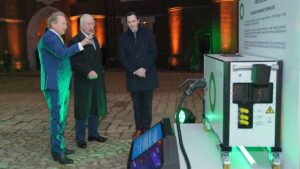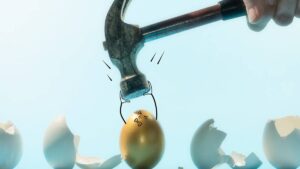Monsters of Rock: Cleantech upstart plays with the big boys in green steel game

Pic: ClarkandCompany/E+ via Getty Images
- Calix runs as it completes FEED study on project to help turn low grade Pilbara iron into green steel
- Comes shortly after BHP and Rio announce landmark trial with BlueScope Steel
- Bulk hauler Aurizon sees big earnings lift on high coal volumes
Last week brought Australia’s warring iron ore factions, once hostile in their attempts to take over the other, into a rare show of unity in a project seeking to develop electric smelting technology that could turn low-grade Pilbara iron ores into green steel.
BHP (ASX:BHP), Rio Tinto (ASX:RIO) and BlueScope Steel’s (ASX:BSL) plan to back a pre-feasibility study that could see a pilot plant developed as early as 2027 was notable not just because it brought together parties often defined by competition and animus.
The reality is both are facing the same problem if the drive to make steel production cleaner truly grabs hold.
Pilbara hematite ores, now largely mined at grades below the 62% Fe benchmark used to price Australia’s flagship export, can’t be used in commercialised electric smelting technology because of their low grades and impurities.
Typically current low emissions steel technology like EAF and direct reduced iron use one of two feed stocks – high-grade magnetite concentrate or scrap steel.
As scrap steel’s availability grows in China, the world’s largest steel producer, BHP and Rio need a way to get their ores, and potentially the even lower grade products of competitors like Fortescue (ASX:FMG), Mineral Resources (ASX:MIN) and Roy Hill into the picture.
Without Australia’s massive deposits of direct shipping ore and infrastructure which took decades to build and perfect, the world would need high-grade iron ore supplies to rise fivefold to 750Mtpa.
That’s a hard ask.
BHP, Rio and BSL think their trial, which would not rely on coal, could deliver steel products from Pilbara hematite with emissions savings of over 80% against blast furnace methods.
“We believe DRI is the most prospective technology to decarbonise our Australian business, and the development of ESF technology is key to unlocking Australia’s unique advantages in this decarbonisation journey – and, more importantly, has the potential for wider adaptation across the global steel industry,” BSL chief executive of Australia Tania Archibald said.
“We believe that this collaboration where we can contribute BlueScope’s unique experience in operating an ESF will be key to cracking the code for Pilbara ores in low emission-intensity ironmaking.”
But there are smaller players looking to craft out space in the market as well, no more prominent than cleantech innovator Calix (ASX:CXL).
Greener iron
Calix has its fingers in a few pies thanks to its electric calcining technology, also applying itself to the task of producing a world first intermediate lithium phosphate salt in a pilot project with Pilbara Minerals (ASX:PLS).
Known as ZESTY (Zero Emission Steel Technology), Calix says it has now completing front end engineering and design on a 30,000tpa demo plant which would use hydrogen to fuel a direct reduced iron process utilising low-grade Aussie iron ore.
The study estimates it would be competitive with existing hot briquetted iron processing operations, using Aussie iron ore to make HBI at an average cost of $630-800/t.
It claims ZESTY could reduce iron ore to metal processing emissions from 1.89t to virtually nothing. Significant since 80-85% of emissions in the steelmaking process come from metallisation.
Calix, which saw its shares lift over 5% today, said test work so far had delivered metallisation rates of 70-95% on a range of Aussie goethite and hematite ore, with iron grades in the final product of between 66-85%.
This product could then be used theoretically in blast furnace and blast oxygen furnace steelmaking.
Further work is underway to see if it can upgrade the iron ore a briquette form suitable for the kind of electric smelting process being conceived by BHP, Rio and BlueScope.
Calix (ASX:CXL) share price today
But coal is still making plenty of money for Aussie resources plays
At the same time, coal remains core to the models of some of our biggest businesses, with haulage provider Aurizon (ASX:AZJ) revealing a big lift in first-half profits and dividends due largely to increased coal and bulk haulage volumes.
Aurizon reported $847m in group EBITDA in the first half, 3% above consensus estimates and 3.6% ahead of the midpoint of its FY24 guidance range of $1.59-1.68b for FY24.
That was 26% up on last year, with net profit up 40% to $237m and Aurizon’s interim dividend 39% higher at 9.7cps.
That’s a 75% payout ratio, something Goldman Sachs analysts said in a note was likely to be matched for the full year ahead of a potential lift in payouts in 2025.
“AZJ stated it expects more flexibility to increase shareholder returns in FY25,” they said.
“This is consistent with prior GSe for an uplift in payout to 87.5% in FY25e although we note Visible Alpha consensus estimates imply ~77% in FY25, only rising to ~84% in FY26.”
Coal was the big winner, with volumes up 4% to 94Mt aided by new customers including New Hope (ASX:NHC) Malabar Resources’ Maxwell mine, SIMEC’s Tahmoor and Pembroke’s Olive Downs (January 2024 on), while AZJ also clocked a 12 year haulage deal for product from New Hope’s New Acland Stage 3 mine, which restarted in October.
Coal revenues rose 11% in the first half to $650m, against a 3% rise in operating costs to $367m, with EBITDA up 23% to $283m. 51% of Aurizon’s haulage volumes came from thermal coal with 49% metallurgical.
It has long-term plans to reduce coal’s share of revenue from 29% to 10-20% by 2030.
Earnings from bulk commodity movements in iron ore, bauxite/alumina and grain accounted for $559m of Aurizon’s $1.972b revenue take, with EBITSA up 12% to $112m and tonnes hauled rising 1% to 34.1Mt.
Its network revenues lifted 23% to $758m, with EBITDA up 34% to $486m against an 8% lift in costs to $272m.
Aurizon Holdings (ASX:AZJ) share price today
Related Topics
UNLOCK INSIGHTS
Discover the untold stories of emerging ASX stocks.
Daily news and expert analysis, it's free to subscribe.
By proceeding, you confirm you understand that we handle personal information in accordance with our Privacy Policy.








